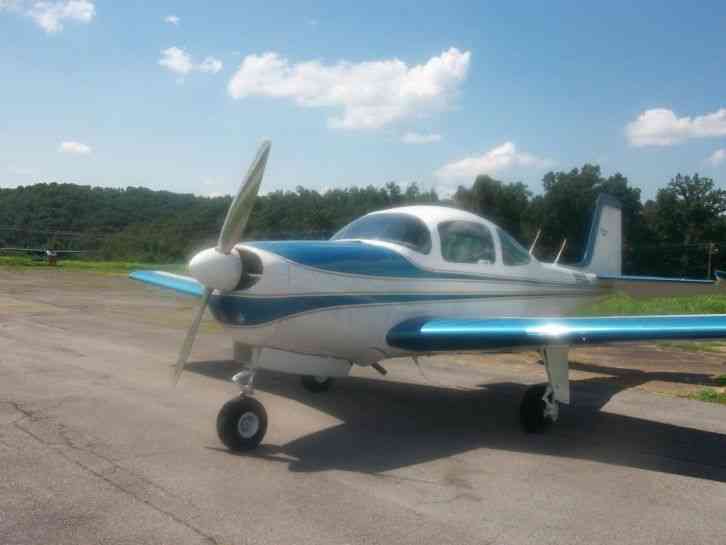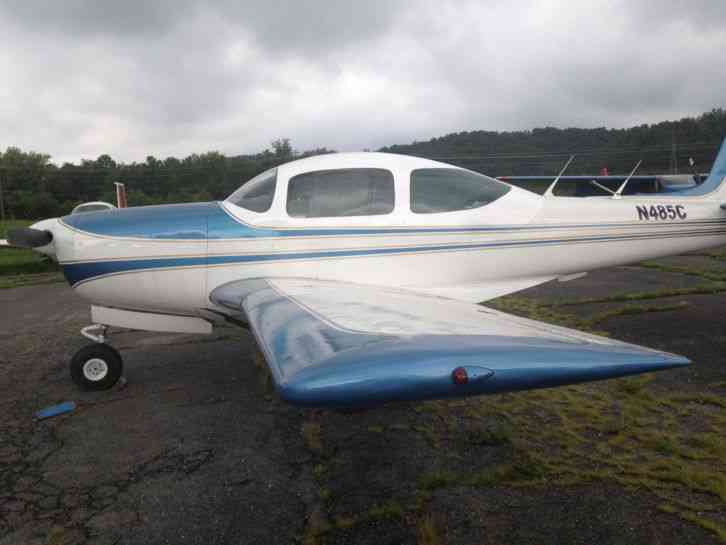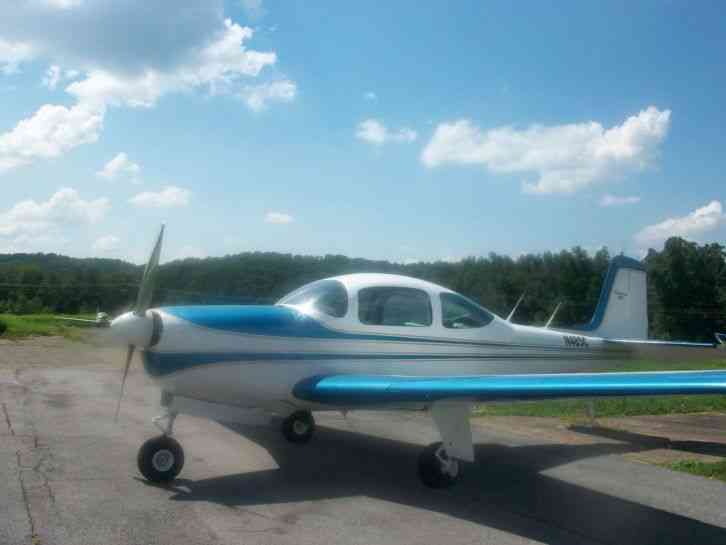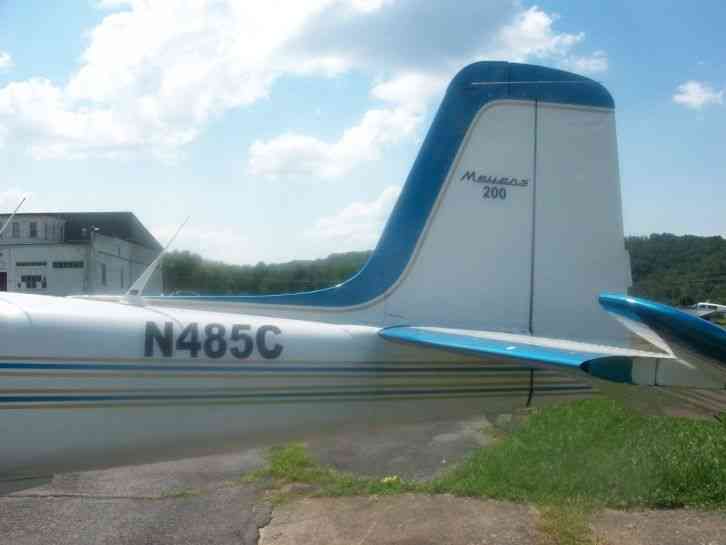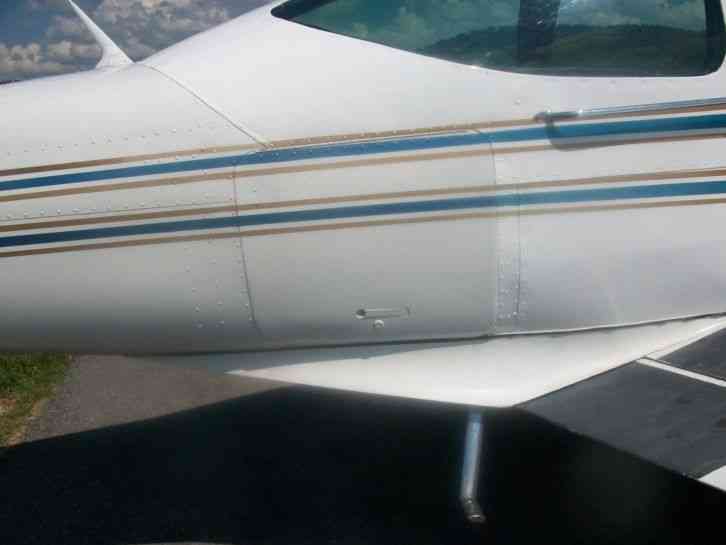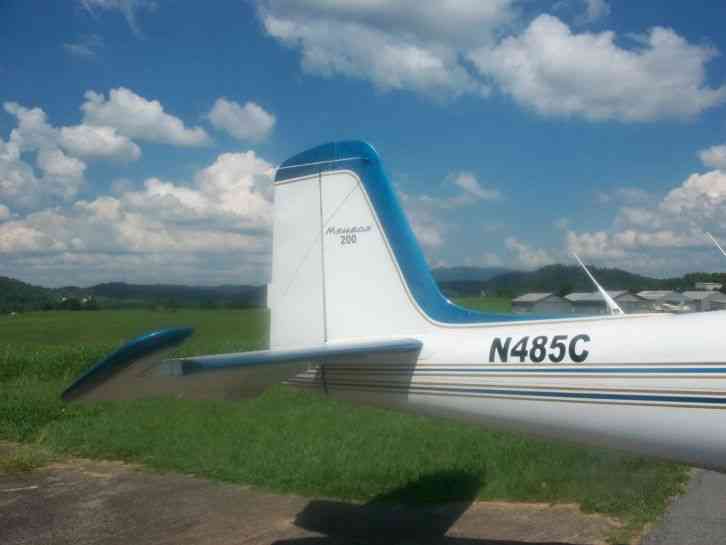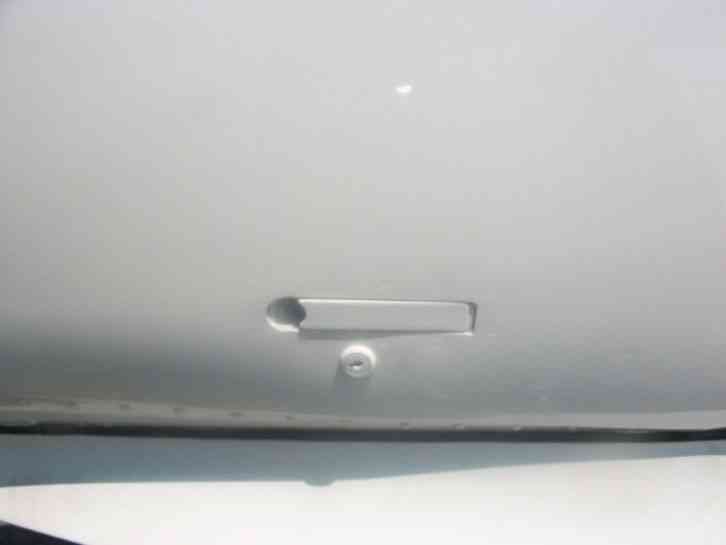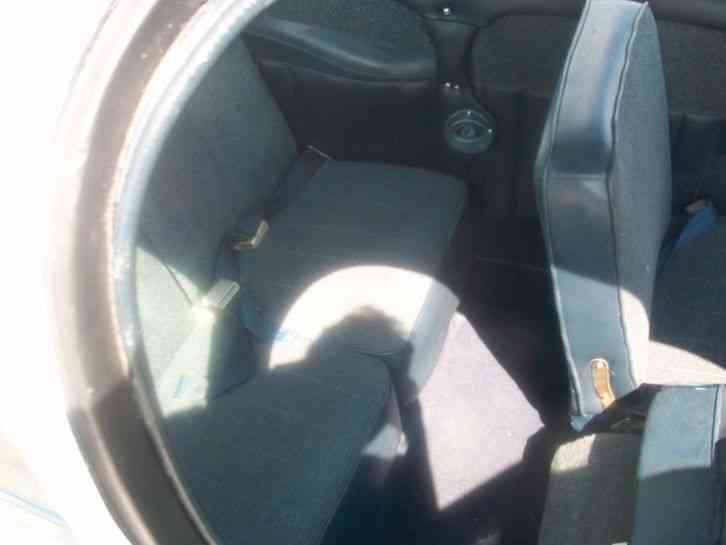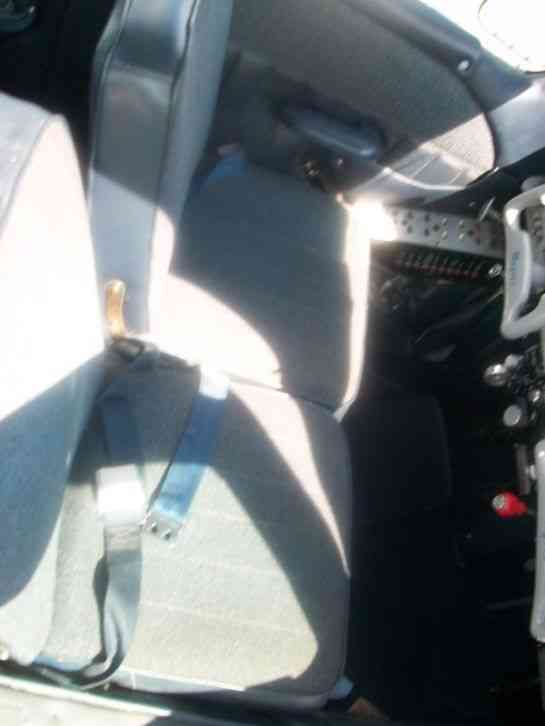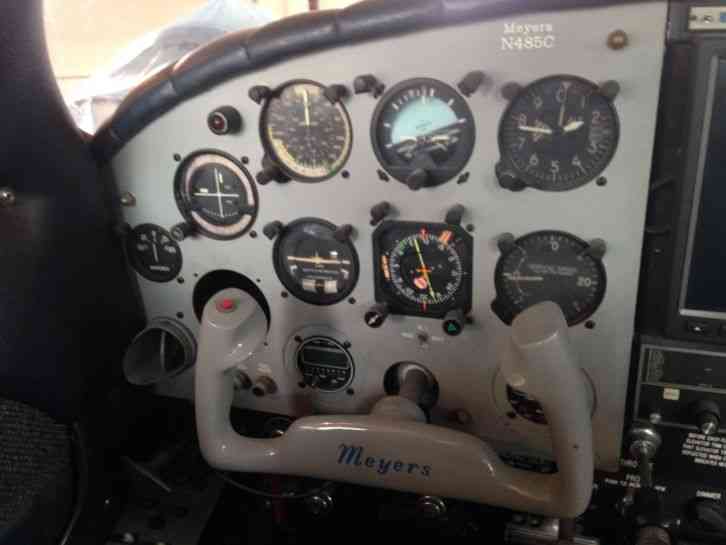MEYERS 200A IF YOU ARE FAMILIAR WITH THE MEYERS COMMANDER 200 YOU KNOW IT IS THE HOTROD OF THE AIR..
Item specifics
| Make: | MEYERS | Model Year: | 200A |
Gluckman Solo Round-the-World Flight
Peter Gluckmann was known as the "Flying Watchmaker." He had been flying for almost ten years hopping oceans on an almost routine basis since 1953. He wanted to become the biggest man (250 lbs) to fly the smallest plane round-the-world breaking the speed record for a solo flight rtw. He chose a Meyers 200A single 260 HP (Continental IO-470D) engine, low wing plane built by Meyers Aircraft Company to make this record-breaking attempt. He added extra ferry fuel tanks and N485C carried "Experimental" markings. His flight plan was made to Federation Aeronautique Internationnale (FAI) standards and his flight log documented 23,765 flown miles. He holds the solo RTW speed record (29D 6H 9M) Departed San Francisco, CA 08/22/59 Mazatlan, Mexico San Jose, Guatemala Puerto Barrios, Guatemala Kingston, Jamaica San Juan, Puerto Rico 08/26/59 (See Note 1) Santa Maria, Azores Lisbon, Portugal Benghazi, Libya Cairo, Egypt Karachi, Pakistan 08/30/59 (See Note 2) New Delhi, India 09/01/59 Calcutta, India 09/02/59 (See Note 3) Bangkok, Thailand (See Note 4) Manila, Philippines (See Note 5) Hong Kong Tokyo, Japan 09/06/59 (See Note 6) Wake Island 09/15/59 (See Note 7) Honolulu, HI 09/17/59 (See Note 8) Arrived San Francisco, CA 09/20/59 >THE MEYERS USED A SINGLE FUEL GUAGE WITH SELECTOR DECIDING WHICH TANK TO SHOW. THAT WAS A WEAK POINT, N485C HAS INDIVIDUAL FUEL GUAGES AS SHOWN. SINCE I AM ABOUT TO HANG IT UP AFTER MORE THAN 50 YEARS AND 35000 HOURS I AM LETTING MY BOSE HEADSET GO WITH HER. HAVE ENOUGH HEADSETS FOR THE 4 PLACE INTERCOM ALSO. N485C FLEW AROUND THE WORLD BUT THE LONGEST FLIGHT I MADE IN MEYERS WAS TO BIGGEN HILL IN LONDON ENGLAND. Dean Siracusa of Austin Texas is a kind of Meyers Guru, having written extensively and is honcho of the Meyers owners association. A good man to know as he has access to manuals and lots of paperwork. Plane & Pilot - October 1966 Inflight Test: Aero Commander 200 By Don Downie Want to fly the fastest conventional four-placer in the country? Then head for your nearest Aero Commander showroom and ask about their 200. It"s won the Pendleton, Oregon, races for the past" three years, finished 1-2-3 in Phoenix in 1963 and Game in 1-2-3 and 4 at Bakersfield this year. Just for good measure; last July 3rd two Commander 200s set new speed records in the C-1.b and C-1.c class flying at 227.6 MPH and 239.5 MPH respectiveIy over a measured 3 ~ilometer course. Last September, Jerrie Mock set 203 .858 miles per hour world"s record in the 200 flying over a 500 kilometer dosed course. The winner of the Bakersfield and Pendleton airplane races, and holder of one of the 3 kilometer records, Bill Broadbeck, checked us out in the 200. His average speed at Bakersfield for 100 miles around a 4 mile, 6-pylon course was 199.9 MPH. Used Airplane Pilot Report - The Aero Commander 200 text and photographs by Norbert Aubuchon AERO COMMANDER 200s are said to be the fastest piston-driven, four-place personal singles extant. Bonanzas wobble, in their wakes, and even Comanche 400s fall behind. The 200s fly like dreams; they are extremely strong; when new, they could be bought for about $30,000; yet there were only 133 made. Today,they are orphans but dearly loved in spite of their foibles by a small coterie of owners, former owners and a few knowledgeable onlookers. The 200 was designed and originally built by the Meyers Aircraft Company, of Tecumseh, Michigan. There were only 48 Meyers 200s built before Rockwell-Standard bought the rights in 1955 and, with difficulty, built 85 more. After the North American Rockwell merger, the rights were shelled off to Interceptor Corporation, an F. Lee Bailey enterprise, which mounted a gas turbine in the nose, and pressurized both the cabin and the price tag. My introduction to Snyder"s airplane was almost theatrical. I waited witH a pilot friend in front of dingy hangar doors. They parted as curtains on a stage to reveal a glittering white-and-orange flying machine; its shape snapped out in sharp contrast to the murky interior of the shelter. The sun broke through as if on cue. I half-expected triumphal music. . Snyder was center stage, tugging on the tow bar. He eased his aircraft outside, talking all the while about the exceptional performance that Allen H. Meyers and his small group of craftsmen had created. Snyder stowed the tool, paused to let us absorb. Then he spoke again. "Do you think I"m just an overly enthusiastic owner?" Snyder asked, grinning at my friend, who happened to be an automobile dealer. "No," he said, "you just sound like I do when my used-car lot begins to look like Times Square." Unflinching and still smiling, Snyder began the guided tour. "Note the substantial taper of the wing, and the thick wing root. This feature allows attach points to be positioned farther apart for added strength. The root structure is a welded truss buildup that extends three feet from the fuselage on each side, with conventional construction outboard of that. The span is short, and while the root section is quite thick, the taper makes the average dimension of the airfoil relatively thin. This translates into a high maneuvering speed [115 knots], for One thing. The root contains four 20-gallon tanks. That"s an hour and a quarter each at almost 175 knots at 55-percent power." . My eyes traveled to the curious-looking stall strips on the leading edge. These were short, hand cut lengths of copper tubing with the ends pinched flat, pierced and attached to the skin with self-tapping screws. This lashup seemed amateurish, and I said so."Yes, it seems homegrown," Snyder said, "and it is. These aircraft were individually tuned to fine pitch. For example, the strips were cut, tried, cut and tried again until the characteristics of one wing were exactly matched to the other. The same technique was used throughout the airplane." Snyder pointed out a minnow of difference in the semi-Fowler flaps of his airplane. When retracted, the left flap had been made to stop a quarter of an inch before the flush position. He showed how the nosewheel doors had received special custom treatment to achieve a perfect fit The differences from plane to plane are significant in detail all to gain uniformity in the final product. Another important design feature is the teardrop-shaped fuselage, which reduces the wetted area from the passenger compartment aft. Its shape is reminiscent of the Staggerwing Beechcraft. Snyder maintains that had the Wing Derringer been so made, the reduction of drag from this alone might have made the difference between mediocrity and reasonable performance. The three landing-gear wheels are of equal size to provide rough-field capability. Prop clearance, even with compressed strut and flat tire, will get you through. The nosewheel is steerable but stiff. With Snyder "s plane, you cannot make a tight taxiing turn without the help of a brake. I"d guess 200s are all the same; Snyder is touchy about abnormalities in aircraft. The gear operates hydraulically. As a preventive against accidental retraction while on the ground, a switch built into the gear handle mechanism cuts out the starter circuit when the handle is in the neutral or up position. This is fine unless you start the engine before you bump the lever to up. The elevator trim tabs are not only unusually large but hinge on the trailing edge of the tail, and therefore extend back as though they we re a complete afterthought. As you stand at the tail looking forward, you can see straight through the cabin, getting an idea of the enormous visibility afforded by the canopy design. More important, the pilot can see the elevator tabs. This, it turns out, becomes as important for safety as a magneto check. An attempted takeoff with an extreme adjustment is almost sure to render the plane unmanageable, despite the fact that during certification, the FAA somehow became convinced that a 170-pound man could maintain control with one arm during takeoff undersuch conditions. After the ATC was awarded, there was talk at Meyers about recessing the tabs, but this was never done. Walking on. around, Snyder called our attention to the main landing-gear doors, and said these were adjusted to final size and fit after repeated air -to-air inspect ions. The doors and gear need to work right and be rugged to fill the advertised claim that the emergency extension speed is 182 knots. The way aboard is via a hydraulically extended step with a convenient but unsightly handhold that looks like a chrome towel rack. Though excellent functionally, it"s curiousthat an otherwise clean airframe would be garnished with such a blemish. Getting in and out of the cabin is easy except for the copilot His exit is difficult Somehow, quarters are tighter than they look. For the unpracticed, the word is " awkward." The seats are overstuffed and comfortable. There is nothing Spartan here. The 360-degree visibility strikes you immediately, and then you notice the distinctive instrument panel. Flight instruments are all on the left. A complete avionics stack is in the middle, and all power gauges are on the right. The automatic pilot clings to the bottom of the panel"s center section . The entire layout is neat, clean and convenient. On a panel just under the pilot"s left arm are miscellaneous switches, the fuel gauge and the tank-selector valve. Unfortunately, there is no way of getting a fuel-gauge indication before actually turning to the tank in mind. Adjacent and below this side panel are the circuit-breaker buttons. Slightly forward and under the main panel is the manual hydraulic-pump handle. Protruding from the instrument panel are doorknob-type push-pull power controls; no way to the airline-captain fantasy here. Worse, you may be a bit confused. There are four such knobs- prop, throttle, mixture…. and one more . It doesn"t pull or push, through; it twists. It "s the pitch-trim control, of all things. Were this for the ailerons (there is one) or the rudder (there isn"t one, unfortunately), its movement would seem logical, but making a lateral motion to achieve a longitudinal movement is awkward at first It"s like learning to work a new combination lock. "Turn right- nose down- to the stop," Snyder said . "Then left by five half turns. Now, pull the wheel back and look back. If the tabs are close to alignment with the elevator, we"ll keep out of trouble." The idea for this screwy control is claimed by Raymond Betzoldt , former production manager and test pilot for Meyers. "I wanted something different," he said. " But let a guy fly this for 15 hours and he"ll fall in love with it" Different it is. After about three hours in Snyder"s plane, I still had to stop and think which way was "up." However, there is never a time from chock to chock when major trim adjustment is necessary, so fine-tuning works well. The fuel-injected Cont inentaI I0-470U is rated for a continuous 260 hp, , according to the engine book. The pilot"s manual, however, restricts it to 2,700 rpm at full throttle for one minute. Now, with flaps in trail (20 degrees), you aim this bullet down the runway. Don"t be casual about your takeoff. This is no ordinary airplane. If you"ve transitioned with a tail wheel fighter aircraft, it"ll be a piece of cake. If you"ve come from something benign, you have a bit to learn even if you"ve memorized all that you"ve been told about torque. Apply throttle abruptly and you "re going to make a sharp left turn. Guaranteed. Get right rudder and aileron into your act before you ease power on and you"ll have a leg up. Then the zigzagging you do may remind you of nothing worse than one of your early student takeoffs. The forces aren"t difficult to balance with a little practice, but it does take practice. " I"ve had guys get as many as two runway lights the first time they"ve flown this plane," Snyder said. Another event during takeoff caught my attention. It was a slight wobble that occurred an instant after rotation. I couldn"t eliminate it no matter what I did. I asked Snyder to make a takeoff with me observing. He minimized the wobble with conscious effort but didn"t erase it. Later, examining a series of sequential photographs of the airplane that I"d shot during one takeoff run, I noticed that the nosewheel was cocked to the right during the roll. It seemed turned about 10 degrees. Then, during rotation, the nosewheel swung to 15 or 20 degrees. The already strenuous use of right rudder during the takeoff run increases sharply at rotation as the turning force of the nosewheel is withdrawn. Additionally, the rudder effectiveness is diminished slightly at the same time by the horizontal stabilizer as the angle of attack changes. During your first few takeoffs, you may be so preoccupied with the overall performance that you may miss this phenomenon. If you watch the rudder-pedal differential while someone else takes off, you"ll notice about a two-inch difference that snaps to three or four inches at rotation. Ray Betzoldt says he applies forward pressure during the takeoff run. Easing the pressure at about 55 knots, he claims the 200 will fly off itself without noticeable wobble at 65. Since all the relevant forces are always present, I suppose it"s merely a matter of how you arrange for the transfers, but I, for one, would want to know a lot more about this aircraft before attempting a takeoff in a strong left crosswind. Once you"re off, you heft a large aluminum disk upward and 1,000 psi of hydraulics lifts the gear. When the red lights go on, you neutralize the system and bring up the flaps. The hydraulics idle at 300 psi. With power reduced to 24 inches and 2,500 rpm, the rate of climb at 100 knots (best climb) was 1,400 fpm for us. Trimming out for cruise takes a little doing for the uninitiated. I couldn"t believe the nose-low attitude at first. I trimmed more than I thought necessary and was still climbing. Stabilized with 21 inches and 2,375 rpm at 5,000 feet, there it was: 174 knots at 65 percent. Seventy-five percent gave us 179 knots. The book says 182, but it wasn"t quite there with three aboard and full fuel. The airplane seems rock-stable, and your right leg is resting. This machine needs a rudder trim for takeoff and climb, though. The Meyers people felt this wasn"t necessary. Obviously, the Rockwell people agreed. Aileron control is sensitive but a little heavy. There is an aileron trim, but on Snyder"s airplane, it had been disconnected in favor of an autopilot. For pitch, the vernier mechanism with its fine tune capability proves to be excellent. Here we are in an exquisite airplane moving easily at almost 175 knots. The ventilation system is excellent, front and back. The noise level isn"t low, but it is acceptable. The book talks about Super Soundproofing. Well, we can let that go. The narrow span smooth"s the ride. Stalls are benign; the ailerons stay with you after the pitch. You don"t need rudder to pick up a wing. Landing is a breeze, once you get the hang of it. The gear comes down at 140 knots, making an excellent speed brake. The flaps won"t lower until you"re at about 105. However, you can preselect. The flap control will not go to the full 40 degrees until the flaps themselves are at 20 degrees. You can depress the flap handle as soon as your gear is in the green, and matters will take care of themselves for a while. You"ll note no gyrations when the flaps do come down; a mechanical interconnect system automatically compensates to offset the pitching moment normally generated. Now, at something over 80, you hit full flaps. Again , no horsing around with trim. This is a power machine. Down the slope you go at 80, slowing to 70 over the fence. You"re easing the power off with the vernier. Now, as you flare, you"re likely to make a minor mistake. Remove all the power and the plane will thump on. Keep a little power on and you"ll get a grease job. This, incidentally, isn"t a sometimes thing. It"s reproducible about 90 percent of the time. Why is this remarkable machine an orphan? Ask North American Rockwell and you"ll probably get a "no comment" answer. After all, who wants to be haunted by the past if they have new airplanes of lesser performance to sell? I turned to Tecumseh, and Ray Betzoldt kindly reviewed the history. Back in the early 1950s, public demand for a four-placer made itself known to Meyers. Meyers, Betzoldt and three helpers set out to comply. In 1954, they towed their first mocked-up airframe with a truck to test balance and landing gear. Next, in 1956, came the pre-prototype. It ticked off 152 knots with a 225-hp engine-almost 10 knots faster than expected. In 1959, the prototype flew, and enough engineering drawings were made to satisfy the FAA. The ATC and the first sale were completed that year. Meyers had a factory force of 25 people who handcrafted the planes until 1965, when Rockwell-Standard came along with enough money-reportedly an even million dollars-to buy Meyers"s profitable business. . Peter Gluckman circled the globe in a 200 with 480 gallons of fuel. An "overload" of 200 to 300 pounds is not the least bit uncomfortable, I"m told , but the low gross of 3 ,000 pounds is likely to remain unless some commercial interest with more moxie than Rockwell had comes along to do the "impossible." Article republished courtesy of and copyright by Flying Magazine. All Rights Reserved. Go Current date: 2015-07-29
